~
Student Association
Steins - A Pictorial Essay ~
by Master Steinologist Walt Vogdes
In this pictorial article we will look at a variety of student
association coats-of-arms (German, Wappen),
steins, lids and inscriptions.
If for no other reason, student association steins are collectible because of their bright colors and badges, and the sense of history and tradition they convey. These beautifully decorated steins were common gifts between members of the same association, and they signified a special and lasting bond of friendship. Factors which add to their desirability include Zirkels on both body and lid, and an inscription which includes the date and names of both the owner and the presenter, the names being followed by the Zirkel of the association. Occasionally, in perhaps 1-2% of the cases, we see a stein displaying the Wappen of two associations, usually side-by-side. In most cases where two Wappen appear, the Zirkel in the inscription will reveal that both men belonged to one of the associations (presumably at the time of the presentation) and one belonged to both of them. This would occur when a student began his studies at one school where he joined his first society, then continued his studies at another school, joining the second association. A second possibility is that the Wappen represent two societies which merged at some point, and chose to display the arms in combination from that point forth. Triple-Wappen student association steins are also known, but very rare.
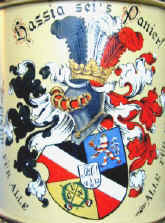 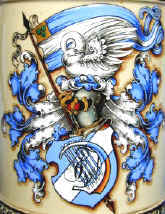 |
The Wappen seen at
far left is that of Corps Hassia Giessen. A dedication on the body dates it to 1887. The heavily enameled arms to the right, surmounted by swan and banner, and featuring a harp on the shield, belongs to the Polytechniker-Gesangverein Hannover. There is no inscription to provide a date or other identifying information. |
| In the photo at right, left to right: A Mettlach half-liter stein, form 1526, decorated on the body with a large Zirkel for Akademischer Turnverbindung Arminia Berlin. A porcelain stein displaying the arms of Katholischen Studentenvereine Arminia Bonn. The inscription is for the winter semester, (18)94/95. A Mettlach half-liter, form 1526, with a Doppelwappen. The arms to the left are those of Giessener Wingolf, while those on the right seem merely decorative. The dedications on student steins need to be examined carefully, as they often reveal considerable information. The inscription at right appears on the stein in the center above (Arminia Bonn). It indicates that Karl Wirsel, a member of three different associations, presented this stein with affection to Karl Bohn. The inscription indicates that Wirsel was a mentor of Bohn's, a special relationship lasting for life. |
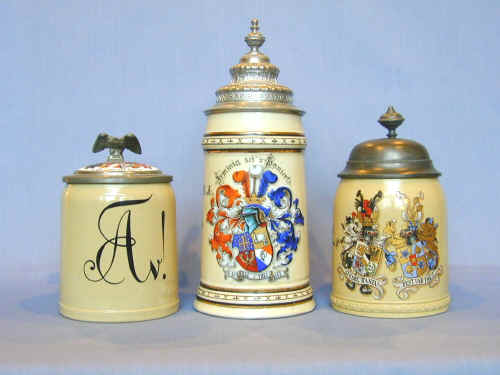 |
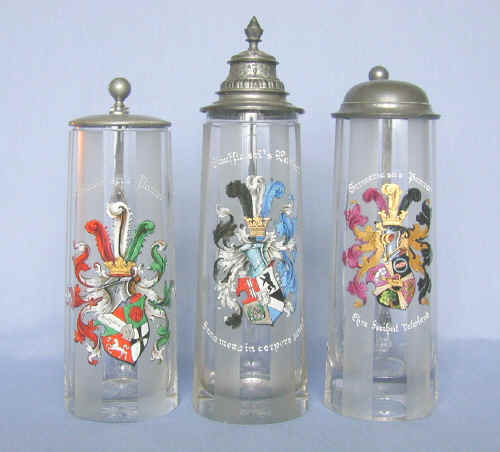 |
Shown
at left are three clear, blown glass steins with enameled student
association decorations. The bodies are faceted, and the panels
alternate clear
and frosted. Each of the steins contains an enameled dedication between
the
upper and lower handle attachments, with dedication, names, Zirkel(s)
and
date. From the left, the societies are Saxonia Münster i. W. (1903), Turnerschaft Stauffia Berlin (1905), and Germania Tubingen (1901). |
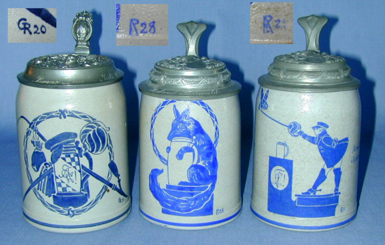 |
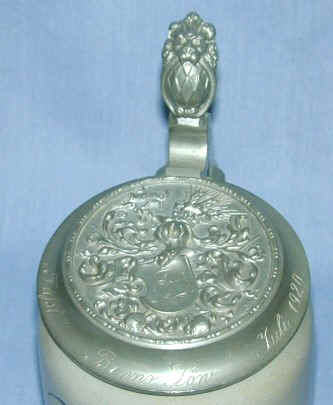 |
| The three blue and gray transfer decorated
student steins were designed by
Franz Ringer. From left to right they depict articles of student life;
the fox, a student society initiate with arms wrapped around his stein
of beer; and a dueling student,
chasing the owl of learning away from his beer stein with his sword.
The absence of a Wappen makes these steins much more difficult to
identify.
The signatures on each stein are shown in the insets. At right above, this relief lid is on the Ringer stein to the left. The design is a "generic" shield with helm, mantling and crest. The shield contains the same Zirkel as the body. The thumblift is an unusual figural lion with the shield of Bavaria in its mouth. |
|
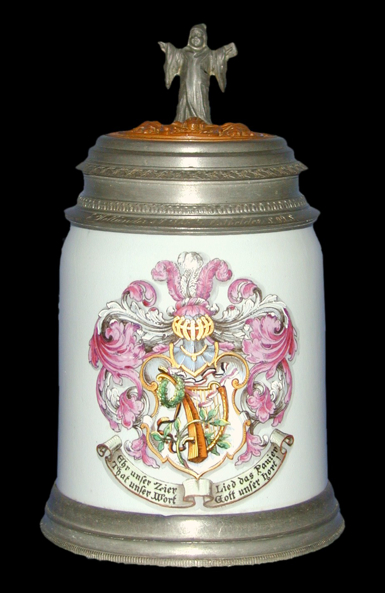 |
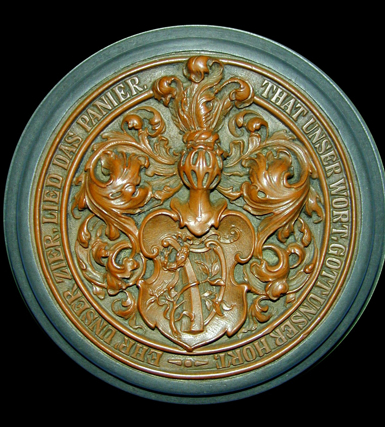 The stein at left is for a
student choral society in Munich. The copper
inlaid lid which repeats the Wappen shown on the body is particularly
nice. The pewter thumblift is the Münchner Kindl, ubiquitous symbol of
Munich. |
| Right, two student steins produced during the Jugendstil era.
Both steins bear the braungeflammte
(brown flamed) glaze which was popular beginning around 1908. The stein on the left identifies the society name as "Frisia," although I have not been able to identify or date it further. The pewter lid incorporates the thumblift directly into the relief design. On the right, a stein by R. Merkelbach. The arms belong to Kurhessen Marburg a.d.L., and the association name appears on the side. An inscription is enameled on the rear of of the stein, with date of (19)13/14. |
|
| Student societies continue to preserve tradition and a sense of identity and honor, to the present day, and most of them have their own sites on the internet. | |